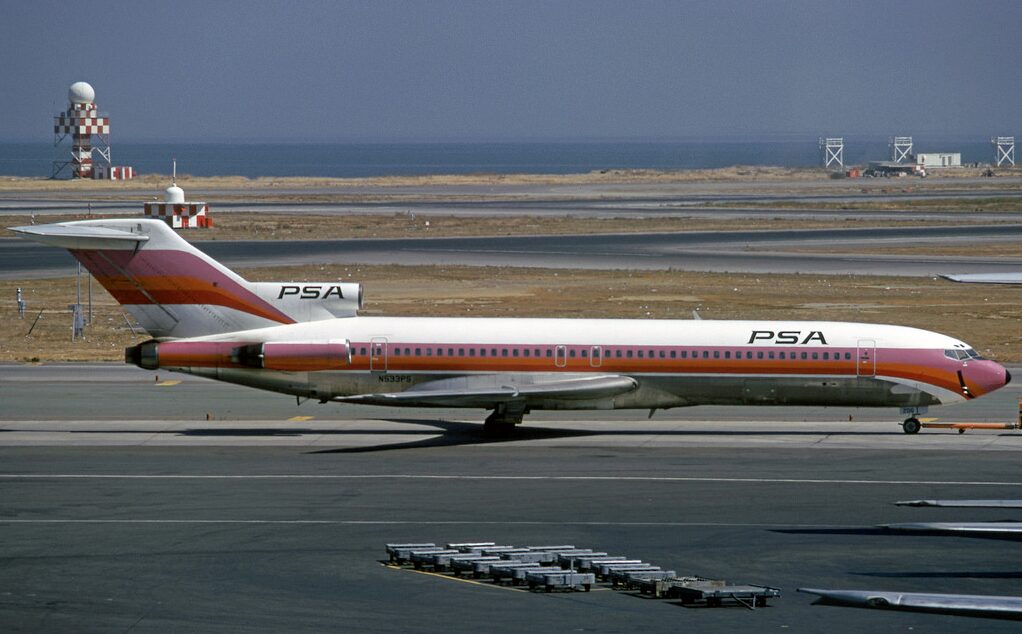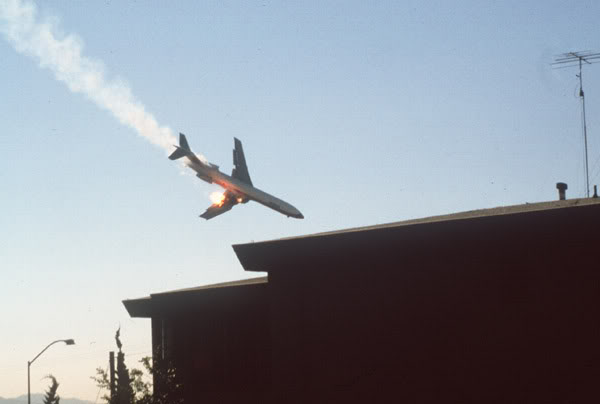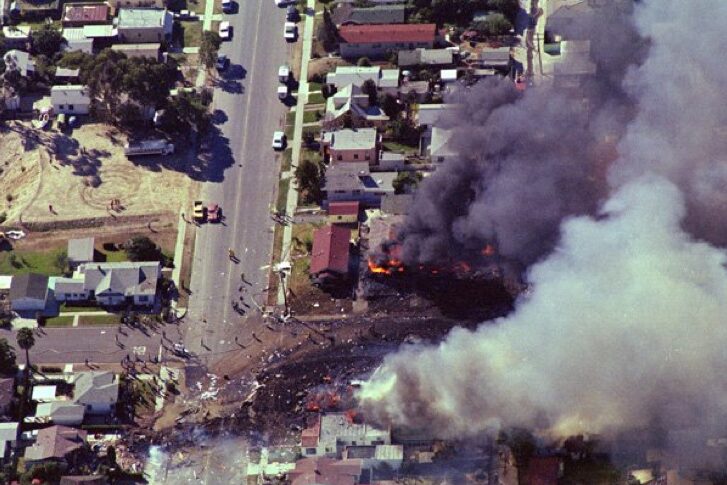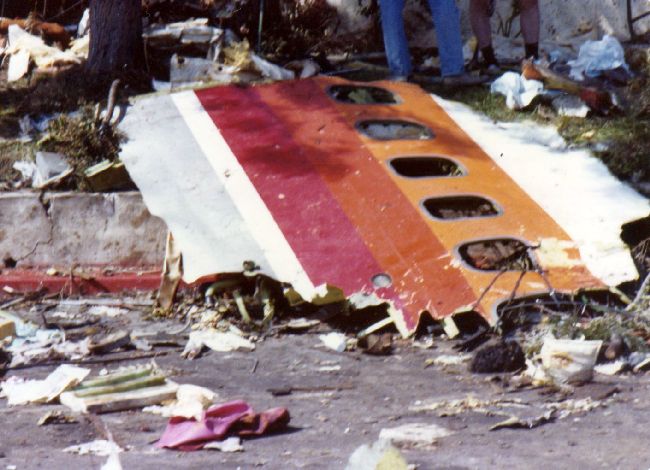PSA Flight 182 Crash:
“This is it, baby.”
The thought of death leaves me in perfect peace, for I have a firm conviction
that our spirit is a being of indestructible nature: it works on from eternity
to eternity; it is like the sun, which though it seems to set to our mortal eyes,
does not really set, but shines on perpetually.
–Johann Wolfgang von Goethe

On a bright Monday morning, September 25, 1978, PSA Flight 182 left Sacramento and was on its way to San Diego with a stopover at Los Angeles. The San Diego-based crew included, 17-year veteran Captain James E. McFeron, 42; First Officer Robert E. Fox, 38; Flight Engineer Martin J. Wahne, 44; and four flight attendants. In addition, off-duty PSA captain, Spencer Nelson, was riding in the cockpit’s jump seat.
First Officer Fox, who had a total of 10,049 flight hours, was the pilot flying the Boeing 727-214.

Ahead of the 727, a single-engine Cessna 172, N7711G had made two practice instrument landing system approaches to Runway 9 at Lindbergh Airport and departed to the northwest to return to its base at Montgomery Field, 6.4 miles north-northeast of San Diego.
Two pilots occupied the Cessna: Martin Kazy Jr., 32, an experienced instrument flight instructor from the Gibbs Flite Center out of Montgomery Airport; and student David Boswell, 35, a U.S. Marine Corps sergeant, who’d flown 407 hours.
Approach Control called, “Cessna 7711G, radar contact, maintain VFR at or below 3500 [1,067 meters], fly heading 070, vector (for) final approach course.”
Though Boswell acknowledged the 070 east-north-easterly heading and the altitude restriction, he failed to maintain either and never notified ATC of the course change. A minute later, the Cessna turned 20° right to 090°, the same heading that Flight 182 held.
Fifteen seconds later, at 08:59:39, the approach controller at Lindbergh Tower alerted the PSA crew about a nearby Cessna 172, which the 727 crew had in their sights.
“Additional traffic’s twelve o’clock, three miles, just north of the field, northeast bound, a Cessna One Seventy-Two, climbing VFR out of one thousand four hundred.”
At 08:59:50, First Officer Fox said, “Okay, we’ve got that other twelve.”
Flight 182 switched radio frequencies and Captain McFeron checked in with the tower: “Lindbergh, PSA 182. Downwind.”
The Tower controller responded, “PSA 182, Lindbergh Tower, traffic 12 o’clock, one mile, a Cessna.”
In the cockpit, however, confusion soon arose about the reported conflicting traffic as the Cessna had dropped out of view. The PSA pilots speculated about its position.
Captain McFeron asked, “Is that the one we’re looking at?”
Flight Engineer Wahne replied, “Yeah–but I don’t see him now.”
McFeron called the Tower, “Okay, we had it there a minute ago.”
The Controller replied, “One Eighty-Two, roger.”
Due to radio static, Lindbergh Tower received an incomplete transmission at 09.00:50: The Captain said, “I think he passed off to our right,” but Lindberg heard, “He’s passing off to our right,” which had a subtle yet significantly different meaning.
Lindbergh Tower returned with, “Okay, Sir, maintain visual separation, contact Lindbergh Tower 133.3. Have a nice day now!”
Lindbergh Tower assumed the PSA jet had the Cessna in sight, thus maintaining visual separation. Flight 182’s crew never explicitly alerted the tower about losing sight of the Cessna.
Considering the potential consequences, it’s a wonder that neither the crew nor ATC sought clarification about the Cessna’s position–if they had, the crash might not have happened.
And why had the Cessna crew altered their course?
Approach control also picked up an automated conflict alert, but never warned the PSA crew, later claiming that such alerts were common even when no conflict existed.
The Cessna was actually in front of, and below, the 727, the yellow fuselage blending in with the yellow-tinge of the sun and homes below, effectively camouflaging the small airplane.
Lindbergh Tower authorized Flight 182 to land, “PSA 182–cleared to land.”
McFeron acknowledged with, “PSA 182’s cleared to land.” He then asked the flight engineer, “Are we clear of that Cessna?”
Wahne said, “Supposed to be!”
McFeron responded, “I guess.”
In the cockpit’s jump seat, one of the two off-duty captains, possibly Spencer, said, “I hope!”
Someone laughed.
At 09:01:21, Captain McFeron stated, “Oh, yeah, before we turned downwind, I saw him about one o’clock, probably behind us now.”
The crew’s nonchalance about the potential conflict is baffling.
First Officer Fox called for the wing flaps to be lowered, and then, at 09:01:31, he asked for the landing gear to be lowered. At 09:01:38, Fox said, “There’s one underneath…I was looking at that inbound there.”
As the 727 descended, it closed in on the smaller plane, which had taken a right turn east. At 09:01:47, the Boeing’s cockpit voice recorder picked up the sound of the collision, which occurred at about 2,600 feet with the 727 plowing into the Cessna’s rear with a thunderous force. The 727’s right wing ripped through the single-engine plane like a knife, tearing it apart and instantly killing both pilots.
The pilot’s dead body hung out of the twisted metal as the spinning remains of the Cessna plummeted from the sky. It crashed on Polk Avenue between 32nd and Iowa streets.
The airliner was also heavily damaged, having lost the number 5 and 6 leading edge flaps, the number 3 leading edge slat, and number 4 inboard leading edge flap. Chordwise damage penetrated to the forward wing spar. With the flight controls damaged, the wing only had partial hydraulic pressure.
The Cessna’s fuel tank had lodged in the 727’s damaged right wing, commingling with the airliner’s leaking fuel lines, which were routed along the wing’s leading edge, and igniting into a raging inferno.
“Whoop,” said McFeron.
“Aaaargh!” said Wahne.
Witnesses on the ground heard a loud metallic “crunching” sound, then saw a massive fireball. They watched the catastrophe unfold with stunned disbelief as the plane, right wing consumed in flames, spun out of control.
“What have we got here?” said McFeron. A moment later, he added, “Easy, baby! Easy, Baby!”
“It’s bad,” said Wahne.
“Huh?” the Captain said.
“We are hit, man. We are hit!” said Wahne.
The plane began to bank to the right, and then began rolling more and more steeply, pulled down from a damaged wing, which affected the plane’s aerodynamics. Controlling the 727 became impossible. Now, the craft was accelerating–falling toward the ground.
A stall warning blared as the right wing continued to lose lift.
Captain McFeron issued a frantic distress call. “Tower, we’re going down. This is PSA!”
“Okay, we’ll call the equipment for you,” the controller said–as if that mattered, considering the grim situation.
On the plane, it had become clear that the end was near. The crew’s last words were caught on the flight recorder.
“Whoo!” someone screamed.
First Officer Fox unleashed a string of expletives.
“This is it, baby!” Captain McFeron told Lindberg Tower. Then he spoke to the passengers: “Brace yourself!”
“Hey, baby!” someone, possibly McFeron, shouted.
“Ma, I love ya!” someone else said.
As Hans Wendt, chief photographer for San Diego County, was covering the opening of a service station in North Park, he looked up to see the fiery collision. Working with lightning speed, he aimed his lens on the ill-fated 727, capturing two photos that would fill newspapers and shock the world.

At 09:02:07 a.m., in excess of 200 MPH, the Boeing, right wing engulfed in angry flames, came down in North Park, just north of the intersection of Dwight and Niles street and six blocks from where the Cessna had come down. Banking at a 60 degree angle, the plane cut through the roof of a residence and embedded into the garage’s cement floor, instantly disintegrating. The concussion of the impact blew out windows in surrounding homes. An ominous, black mushroom cloud could be seen for miles.
All 135 people on flight 182 were killed and seven people on the ground, including five women and two children. Thirty of those on board were off-duty PSA employees who were deadheading.
Nine others on the ground were injured and twenty-two residences were destroyed or damaged by the impact and debris.

Amid the wreckage, which spread over four residential blocks, a horrendous fire threw out 400 feet waves of black smoke. San Diego was already in the unrelenting grip of a severe heat wave with temperatures exceeding 100 °F, but a witness said the collision, “made it feel like 200 degrees.”
Another said her “apples and oranges baked on the trees.”
Whole neighborhoods were ablaze in a deadly wall of fire. The air filled with the acrid scent of jet fuel and burning flesh, making eyes and throats burn. Ash, paper, twisted metal, and luggage flittered through the vile air. Body parts littered the street, dropped onto rooftops, yards, and into trees. One tree draped with numerous body parts looked like a Christmas tree from hell. Witnesses described a landscape of airplane parts, chunks of flesh, eyeballs, and fingernails.
A young lady who lived in the neighborhood lost her life from flying debris which impaled her onto a street sign.

First responders had difficulty controlling the crowd. People, screaming and crying, shuffled along the chaos in a state of utter shock and confusion. Some unsavory characters dared to steal items at the crash site, such as luggage or jewelry from the dead, until police intervened.
Body parts were bagged and taken to the St. Augustine High School gymnasium, which served as a temporary morgue. Only four intact bodies were recovered from the crash site, which included McFeron’s.
One especially gruesome account is that of the “Flying Superman,” a screaming male passenger which witnesses described as forcibly ejected, headfirst, from the plane’s fuselage. Arms outstretched like Superman, he flew from the wreckage, screaming all the way, with such force that he became something of a human bullet before he impacted the rear window of a parked vehicle two blocks from the crash site. Two emergency responders at the scene covered the car and later removed him from the automobile.
Allegedly, this story was squashed by the newspapers at the time as being deemed too gruesome and upsetting. It’s disturbing that this poor victim is known only as the “Flying Superman” or “Screaming Superman.” As little is known about his identity, some question whether this account is true, but apparently it is as many witnesses have confirmed it.
In addition, he may well have been conscious during his two-block flight through the neighborhood, because anything is possible in a crash as Juliane Koepcke proved. She fell 10,000 feet from an airplane in 1971 after LANSA Flight 508 was struck by lightning and began to disintegrate before it crashed into an Amazon rainforest–and yet she survived.
Here are a few witness accounts regarding the Screaming Superman.
“‘Superman’ was witnessed by, I believe, it was three or four residents on Nile, all of which required hospitalization, as did two emergency responders at the scene who removed him from the automobile. In late 1999, at a party in North Park, I met a woman who was a flight attendant for PSA in 1978. The subject of the crash came up, and I told her the stories I’d heard about Superman. She mentioned that particular man was identified as an off-duty PSA employee and mentioned the name but I have long since forgotten it. I have no reason to doubt this as fact.”
“I just called my ex-wife’s sister who was a coroner for 11 years, and she said what likely happened, and it is purely conjecture based on her two or three small aircraft crash investigations, is that the man was most likely at the rear of the aircraft, was already screaming as the plane went down, and was thrown to the left of the aircraft as that portion of the fuselage ‘opened up,’ and freed him from the deceleration quickly enough to prevent a basilar skull fracture, we are talking milliseconds here. Thus, he was conscience and alert upon ejection, and would have, unless he passed out, about three seconds of awareness before impacting the car. In her opinion, that would be a substantial enough time to produce the scream people allegedly heard.”
Another witness said: “The guy next door was literally hospitalized because he survived the plane crashing near his house as he was in the front yard mowing, but saw a human being fly down the street, prone ‘like Superman,’ flying in the air. He used to say, the man ‘flew about thirty feet above the street’ until impact. He said the man had a high-pitched scream like a pig screech. He could actually hear that amongst the concussion and explosion. The flying man ended up impacting a car a couple houses down.”
“I recall the car with the prone body sticking out the back. It’s true. It did look as though it was Superman, arms outstretched and all. They covered the whole car by 2 p.m. or so.”
“I heard about the flying/screaming man when my husband and I moved into the neighborhood in 1996. There were only a couple people on Nile still living there (that we knew of at least) who were around when this crash took place. One of them told us about this guy as she actually saw it happen. She lived on Nile facing West, about four or five houses down from Dwight. She said she was tending to her plants in the front yard when this crash happened. She actually saw the whole event start to finish. She said when the plane impacted she threw herself to the grass instinctively. The man in question flew past instantly when the ‘big hole ripped open after the wing hit the house on the corner of Nile and Dwight,’ and she described him as screaming “like a cat in a cat fight,” arms outstretched, prone. Yes, she said, “Superman.” He went further down the street and hit a car with a thud sound she said she’d never forget. She used to describe it as like throwing hamburger meat down on the counter.”
“When I interned at the San Diego Union in the late 80′s I mentioned this to a reporter who won some sort of journalism award covering that crash, and he said, in fact, the story was confirmed by three or four of the actual eye witnesses to the crash, a photo was taken of the impacted car, and then the editors decided to ‘spike’ that item because they deemed it ‘too disturbing on an already disturbing day.’”
The Flying Superman, whoever he was, supposedly haunts the area, but the unfortunate soul isn’t the only one. Within five years, the nightmare scene was cleaned up and new houses were built. For many years people still found bones in gardens and gutters, but not a visible trace of the tragedy remained. Newcomers to the area knew little to nothing about the tragic events that had happened there, making the supernatural activities they experienced at the crash site especially mind-boggling.
Ever since the crash, the site has supposedly been teeming with paranormal activity. Residents report disembodied voices, screams, and other unearthly noises, knocks on their walls and front doors in the dead of night, and other spooky phenomena.
Dishes clatter in cabinets and often slide off tables, crashing to the floor. Doors creak open and slam shut for no reason.
A witness who lived in the area as a child claimed that a child between the ages of three and six would play with her toys in the middle of the night and disturb her sleep. This makes sense as two young boys were casualties on the ground, and a three-year-old was killed at a daycare.
Some even report something scarier, black shadow figures roaming their property.
For many others, however, the haunting was more subtle such as an “eerie feeling,” or recurring nightmares about a plane crash. Some couldn’t understand why these inexplicable things were happening until they learned about the crash years later.
A witness who lived in the area said, “The whole area is just not right. There is an energy that I can only describe as “off.”
Another witness said, “I used to live close to the impact site from the late 80s through the 90s, and into the 2000s. To me, the area had a bad vibe, and I knew a guy that lived in one of the houses that were built as a replacement to the old houses destroyed in the impact. And that house to me had a very unpleasant feel to it, and I don’t know how he could stand to live there.”
The crash happened long ago, but a tragedy of such magnitude scared the neighborhood permanently and in countless ways. Perhaps some of the ill-fated passengers and crew members remain earthbound there. We can only pray that the victims of PSA Flight 191, eventually cross over and find peace.
-THE END-
During the research and writing of this account, this tragedy hit me hard, obsessively lived with me, even cutting into my dreams. The crash is a part of me now and will always be with me–so many lives lost and dreams destroyed, so much pain for loved ones, co-workers, and friends. The sense of loss and devastation was, and remains, unfathomable. It helps to remember that though our bodies are frail, our spirits live on. They still, and always will, exist. The truth is, this isn’t it, baby.
Those lost on September 25, 1978
Billy Adams, San Pedro
Judy Allen, Los Angeles
Don Ashcroft, Sacramento
Daniel Lawrence Balson, Encino
Leonard Barr, Loomis
Mary Beard, Sacramento
Frank Becwar, Fair Oaks
Robert Benner, Thousand Oaks
Sue Benner, Thousand Oaks
David Bernard, Santa Monica
Paula Blake, Playa del Rey
Barbara Boisselle, Los Angeles
Bryce Bonner, Los Angeles
Karen Borzewski, San Diego
Charles Bren, Los Angeles
Ronald Henry Burkley, Manhattan Beach
Arnold Lee Califf, Poway
Joseph Reed Canavin, Andover, MA
Hood Cheney, Dallas
Lynnette Cherry, Yakima Valley, WA
Pauleen Colarich, Concord
Martha J. Coleman, San Diego
Alberico Coluzzi, Los Angeles
Richard W. Conway, San Diego
Carol Cook, Rolling Hills
Christine Davie, Carlsbad
Lisa Denise Davis, Lakeside
Olga Robles de Huante, San Diego
Timothy DeLucca, Aptos
Jeri Dickson, Los Angeles
Janet Dolson, Inglewood
James W. Dormer, San Diego
Jay Drotman, Santa Monica
John Dumas, Los Angeles
Kirk C. Dutton, Los Angeles
Amancio R. Elizaga Jr., San Diego
Mario Escalante, Sacramento
Jonathon Falk, Los Angeles
Michael Fitzgerald, San Diego
Perry Flashman, Culver City
Catherine Fons, La Jolla
Gail Michele Forsyth, San Diego
Gary Fox, Culver City
Robert E. Fox, La Mesa
William Francis, Sacramento
James Gallagher, Bakersfield
Maureen Gallagher, Bakersfield
Jay Gilroy, Tacoma
Robert Guerrero, Sacramento
Jacob Joseph Gustincic, Marina Del Rey
Lewis Hayden III, San Diego
Harold Steven Henry, Sacramento
Richard Hight, Citrus Heights
Richard Horne, Glendale
Jack Irwin, Sacramento
Barbara Jackson, Los Angeles
Nellie Jackson, Sacramento
Andrea Jacobson, Belmont Shores
Neil Howard Jagoba, Framingham, MA
George Johnson, Thousand Oaks
Lee H. Johnson, La Jolla
David L. Jolliffe, Los Angeles
Valerie Kantor, Pacific Palisades
Mahmoud Kaffaf, Alshaya, Kuwait
Jimmie Kelley, Savannah, Ga.
Colleen A. Kepler, San Diego
Farrell Kimball, Sacramento
Allan Lebow, Los Angeles
Wayne Allen Levin, Beverly Hills
Robert Levine, San Diego
David Loeb, Santa Monica
Rosalia Lococo, El Cajon
Earl Lohnes, Niantic, CT
Brian T. MacLean, San Diego
Ruben Macias, Hawthorne
Gil A. Marcoux, San Diego
Randolph Martin, Malibu
Louise T. Martin, San Diego
Thomas Masker, Monterey
Deborah McCarthy, Vista
James Edward McFeron, Escondido
Joseph McMasters, Sacramento
Joann Metzler, Thunder Bay, Ontario, Canada
Carl Miller, Davis
Samuel Molinaro, El Segundo
Gary Moore, Sacramento
Wilhelmina Mottola, San Diego
Kenji Nakanishi, Santa Monica
Spencer B. Nelson, Escondido
Betty Nunn, Hayward
Robert Oshiro, Sacramento
Rhona Lynnette Owens, Coronado
Gary Patterson, Highlands
Bernard Perez, Shingle Springs
Jeffrey J. Pesses, Los Angeles
Burt Pierce, Rancho Palos Verdes
Richard Plaskoff, Los Angeles
Anthony Poli, San Diego
Gary Pommells, Citrus Heights
Muhamed Quaffae, Alshwah, Kuwait
Bob Ramirez, Lennox
Leo Reeder, Pacific Palisades
Roni Resnick, Los Angeles
Francis Resnick, Los Angeles
Joseph Rigney, Downey
Randy Ryckman, Santa Monica
Donald St. Germain, San Diego
George Saunders, Rancho Palos Verdes
Marla Scavia, La Mesa
Dave Schmidt, Sacramento
Ralph Schueler, Sacramento
Bennett Schwartz, Culver City
James Seaman, Manhattan Beach
Nerene Faye Seaton, Bakersfield
Gale Shapiro, San Diego
Robert Sinclair Silver, Marina Del Rey
Kirk Smith, Palo Alto
Walter Smith, Citrus Heights
Roger Smith, Waukesha, WI
Herb Leslie Stewart, Monterey
Jim Stinnett, Los Angeles
Michael Sulit, Del Mar
James Michael Taggart, Palos Verdes
Azmi David Taha, Vista
Allen Tetelman, Los Angeles
Betty Maxine Thweatt, Manhattan Beach
Daniel Bruce Urdahl, San Diego
Martin J. Wahne, San Diego
Roger W. Walsh, Solana Beach
William White, Lakeside
Kevin Burke Wholey, Santa Monica
Jane Whyte-Spitz, Bonita
Jeff Wilson, Los Angeles
Lawrence Wilson, Sacramento
Thomas Womack Jr., El Cajon
D’Anne Young, El Cajon
On the Cessna:
David Lee Boswell, Camp Pendleton, Oceanside
Martin B. Kazy Jr., San Diego
On the Ground:
Amy Bolick, San Diego
Nancy Stout, San Diego
Robert Stout, San Diego
Lela Todd, San Diego
Derek Walker, San Diego
Sherry Walker, San Diego
Darlene Watkins, San Diego



